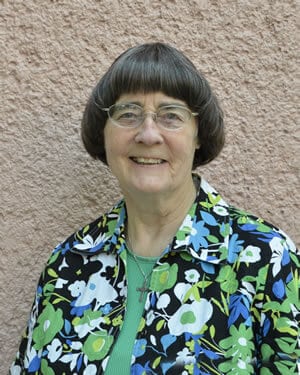Our CCVI Sister Pauline Nugent, Professor of Classical Languages at the Missouri State University, was invited to Oxford, UK, to give a presentation on Women’s Leadership Issues.
Women’s Enduring Leadership
Oxford 2019
By S. Pauline Nugent, CCVI.
At a moment in human history when social media is paying particular attention to the roles and talents of the female gender, this Oxford Conference on Women offers a timely glimmer of hope as we exchange words and acts of wisdom from past exemplars, who can inspire us to seek solutions for two dominant problems facing the present century. These most pressing issues concern the blatant destruction of Mother Earth with its biodiversity, and the callous disregard for human life as evidenced in the hostile treatment of migratory people. Let us begin with a few examples of inspirational women from a wide variety of centuries past, who practiced enduring feminine leadership and served as sources of personal inspiration and unflinching bravery at moments in history when women were largely erased from the chronicles of the times. The central example for this discussion, however, will be an extraordinarily gifted female who dominated the intellectual, spiritual and political world of the 12th. century, and who is currently experiencing a veritable renaissance since the later decades of the twentieth century and well into our day. Her name is Hildegard of Bingen.
Our earliest examples of extraordinary feminine power and influence come from the Hebrew tradition. The Book of Judges, (Ch. 4 and 5), contains the story of Deborah, who served as a judge in Israel. She is described as administering justice on behalf of God. In that role, she gave orders to the military leader, Barak, to march out and subdue the enemies of Israel. But he replied, “If you come with me I will go; if you will not come with me, I will not go, for I do not know how to choose the day when the angel of the Lord will give me success”. She replied, “I will go with you then; but because of how you are going about this task, the glory will not be yours, for the Lord will deliver the enemy into the hands of a woman”. Deborah then stood up and went with Barak; ten thousand men marched behind him while Deborah marched beside him. The Book of Judges, Chapter 5, celebrates this victory in song.
Another Hebrew example comes from the Second Book of Kings, Chapter 22. Hilkiah, the high priest, and his secretary, Shaphan, found a Book of the Law in the Temple and read it to King Josiah. The King then ordered them to consult the Lord on behalf of himself and the people. Hilkiah, Ahikem, Achbor, Shaphan and Asiah—all five leading men in the court of Judah—went to Hulda, the prophetess, who interpretated the contents of the Law for them. In both of these stories, the woman is seen as a wisdom figure and as the intermediary between God and humanity. This is also the situation in the Greek myth of Apollo at Delphi. The god delivers his message to the priestess, the Pythia, who communicates the content to the priest in enigmatic language. The priest then interprets the message in plain text and gives a response to the enquirer who sought wisdom from the god in resolving the major issues of the day. In all three instances, it is the female who is in direct contact with the spiritual source.
But inspiring examples of influential women are not limited to biblical times or the pagan past. The Middle Ages supply an qually inspiring example in the person of Catherine of Siena, who lived in the 14th. century, and who ordered the Pope to return to Rome from his refuge in exile at Avignon. Two centuries later, Teresa of Avila, a 16th. century Spanish noble lady, issued stern directives and formulated a strategic plan that led to the renewal of the Carmelite tradition—a way of life that exists and flourishes even to this very day.
In modern times, we may point to Mother Teresa of Calcutta, who was awarded the Nobel Prize in 1979 for her daring and heroic endeavors to bring relief to suffering humanity in the slums of Calcutta. We also have the example of Sister Helen Prejean in the present decade, who campaigned vigorously against the Death Penalty and whose heroism is portrayed in the film: Dead Man Walking. (starring Susan Sarendon).
We now turn our attention to the 12th. century heroine, Hildegard of Bingen (1098-1179), known as the Sibyl of the Rhine, who serves as the central example of feminine empowerment for the present discussion. Hildegard was declared a Doctor of the Church as recently as October 7, 2012, only the fourth woman in 2000+ years of Church History to be given this distinction. This extraordinary honor signifies a person’s exceptional participation and assistance in the development and discussion of theological ideas and Church doctrine. It was this singular distinction that alerted my attention to Hildegard and prompted my exploration of her widespread resurgence in the latter decades of the 20th. century and continuing even to this day. Dozens of books, documentaries, recordings of her songs, and the 2009 award winning film Vision, share her story with a new generation. Even the distinguished Oxford trained neurosurgeon, Dr. Oliver Sachs, mentioned her in his book on Migraines. In fact, the most recent work to enter the scene, Woman of Light: Discovery of Hildegard of Bingen by Lyn Doucet, just hit the market earlier this month, July 2019.
Hildegard was an extraordinary, gifted woman—exceptionally creative in a wide variety of areas such as natural science, ecology, theology, music, art and medicine. She believed strongly in her own creative powers and often associated creativity with women, naming it our “greening power”, which she saw as a reflection of the vitality and fertility of nature in fruits and flowers and fields. She believed that if the feminine soul were repressed, then all life would be affected and eventually run dry.
As was the case with St. Augustine in the fifth century, and with Martin Luther in the sixteenth, Hildegard too is seen as a powerful leader not only for her own time (12th. century) but also for her impact on future generations. In the Foreword to Nancy Fierro’s book, Hildegard of Bingen and Her Vision of the Feminine, Dr. Anne Eggebroten explains the popularity of Hildegard’s works, saying it is “because of the richness they offer to a world rung dry by reason of technology and male dominance.” “Hildegard gives us a sense of God’s intimate presence—not a male God of punishment, but a Divine Feminine in whom we on earth live and move like babies in a cosmic womb.”
The Austrian born US historian, Gerda Lerner, offers a fitting summary of Hildegard’s significance when she writes: “The life of Hildegard of Bingen exemplifies the breakthrough of a female genius who manages to create an entirely new role for herself and for other women, without ostensibly violating the patriarchal confines within which she functions”. Hildegard’s career as an Abbess of two communities of women brought her into conflict with a misogynous Abbot whom she handled with a strategy worthy of a military general. She wanted more independence for herself and her Sisters than the arrangement the Abbot suggested would allow. Hildegard was also in contact with leading figures of the time, including the Popes, Eugene III and Athanasius; and Frederick Barbarossa, the Emperor of the Holy Roman Empire, who had earlier sought her advice and whose imperial protection she had secured for her monastery. Not a person to shy away from conflict or to gamble with truth, Hildegard upbraided the Emperor when he supported three anti-Popes. She also became a close friend of St. Bernard of Clairvaux, a leading figure in 12th. century ecclesiastical circles, who helped advance her work and who procured Papal approval to document her visions as authentic revelations from the Holy Spirit. She had been receiving visions from the age of 3. But when directed in a vision to write down these experiences, she failed to do so through timidity and fear of criticism. As a result, she then fell deathly ill and only recovered when she finally obeyed the command.
A gifted and creative writer, she produced a large variety of writings on a wide variety of topics. Among others, there are three volumes of visionary theology which covers the entire story of Creation, Redemption and the Final Judgment.
- Scivias (Know the Ways)—a journal of her 26 visions, which concludes with the Symphony of Heaven, an early version of her musical compositions.
- The Book of the Rewards of Life—discussion of the moral life in the form of a dramatic confrontation between the vices and the virtues.
- Book of Divine Works—an explication of the Prologue to the Gospel of John.
In all three volumes, Hildegard describes her visions as well as her interpretations of their theological content. These works would later provide the theological content that occasioned her being named a Doctor of the Church in 2012. Additionally, she composed sixty to seventy musical compositions—one of the largest repertoires among medieval composers. Her Order of the Virtues is the earliest known extant musical drama. In her musical works, Hildegard repeatedly used the term “viriditas” or “greenness” as an earthly expression of the heavenly vitality and fertility – green being her favourite colour.
Her medical and scientific writings stem from her experience in the monastery garden, her service in the infirmary, and her wide-ranging reading in the monastery library. She catalogued her theory and practice in two works: Physica, which describe the medical properties of various plants, fish, animal, etc., and Causes and Cures which explore how the human body relates to the rest of the natural world. She listed the causes and cures of different diseases, burns, fractures, dislocations, etc. Her medical books are historically significant since the areas of medieval medicine are not well documented simply because women, the main practitioners, rarely wrote in Latin. Hildegard repeatedly emphasizes the connection between the “green health” of the natural world and the holistic health of the human person. “Viriditas” was thought to sustain human beings in good health and could be manipulated by adjusting the balance of the four ancient humors of the body since, as she explained, imbalance led to sickness and disease.
While Hildegard probably learned simple Latin with her religious instruction as a Dominican sister, it is highly unikely that she was instructed in the basis of education of the Middle Ages, i.e the Trivium: grammar, dialectic, rhetoric, and Quadrivium: arithmetic, geometry, astronomy, music. However, she participated in preaching, writing books and letters, composed music and poetry, and possessed an encyclopedic knowledge. She was significant as a female rhetorician and ignored the ban on women’s social participation and interpretation of scripture. Public preaching by a woman, even a well-connected abbess and acknowledged prophet, does not fit the stereotype of her time. But, at the invitation of the Emperor, Frederick Barbarossa, Hildegard—already in her late 60’s and early 70’s—preached publicly in Germany between 1160-1170, conducting four tours, visiting over 20 cities, and addressing both clergy and laity in public and private settings—mainly denouncing clerical corruption and calling for church reform. A very modern problem!
Her particular relevance for the 21st. century stems, in large part, from the fact that she loved Mother Earth with a deeply feminine passion and had a profound respect for people as the crown of creation. For Hildegard, the Earth was a living organism containing the vital forces that animated all life. Love and reverence for Mother Earth were central themes in her writings. To quote her words: “The earth sustains humanity; it must not be injured; it must not be destroyed.” She viewed all elements of our world as participants in the chorus of creation, be it the light of the moonbeam, the grace of a swan, or the fragrance of a flower—all were part of the choir of creation, and Creation, she said, is the song of God. To be out of sync with the harmony and fertility of creation, in her worldview, was to deny the divine force that gives life to our body and spirit. She saw the colour green as a force that continually nourishes the earth and all its inhabitants. She was very clear in recognizing humans, not as separate from nature, but rather as an integral part of nature. She admired the splendid wonder of the world and saw a divine underpinning that sustained the earth and the entire cosmos and repeatedly explained Creation as the song of God. In addressing her nuns she once said, “The earth sweats germinating power from its very pores”. She asked her nuns to pay close attention to the rhythms of nature because they hold the secret to our physical well-being and to the vitality of our inner life. She urged them to become partners with the natural world, calling on all to co-create so that we might cultivate the earthly and thereby create the heavenly. Herein lies the stark contrast between the 12th-century mystic and 21st. century political leadership. She saw the need to work cooperatively with nature but, alas, few in 21st. century leadership positions seem to be listening either to the prophets of old or the latest scientific warnings. Today’s climate changes—rising sea levels, failing ecosystems and the destruction of multiple species have brought Mother Earth and her children close to the brink of extinction. Not only that, but the blatant, callous disregard for human life and dignity today, especially with regard to immigrant peoples, but easily extended to include human beings in general, forms an unfortunate corollary to the destruction of Mother Earth.
Hildegard has indeed returned to the 21st. century because we women need her courageous example to challenge us to acknowledge and resolve the lethal issues of life and death that loom ever closer over the 21st. century horizon. Only the “greening” power of females can help stem this disaster before the devastation of life and planet is complete.
This Summer Oxford Conference on Women’s Empowerment and Leadership, is a clarion call to all women everywhere to stem the flood of destruction of people and planet before it is too late. May the words of an Irish poet who used his pen to urge a reluctant donor to contribute to a worthy cause, inspire and embolden us also to act with the same urgency and commitment, as we:
Look up in the sun’s eye and give
What the exuberant heart calls good,
That some new day may breathe the best
Because you gave, not what they would,
But right twigs for an eagle’s nest.
William Butler Yeats
ADDENDA
These are useful references, as listed in Nancy Fierro’s Bibliography, for anyone wishing to become familiar with the life and work of Hildegard of Bingen:
Books about Hildegard:
- Fiona Bowie and Oliver Davies, Hildegard of Bingen: Mystical Writings, New York: Crossroads, 1990.
- Sabrina Flanagan, Hildegard of Bingen: A Visionary Life. New York: Routledge,1989.
- Matthew Fox, O.P., Illuminations of Hildegard of Bingen. Santa Fe: Bear and Co., 1985.
- Barbara Newman, Sister Wisdom. Berkeley: University of California Press, 1987.
- Drs. Wighard Strehlow and Gottfried Hertzka, Hildegard of Bingen’s Medicine. Santa Fe: Bear and Co., 1988.
- Ingeborg Ulrich, Hildegard of Bingen: Mystic, Healer, Companion of Angels. Trans. By Linda M. Maloney. Minnesota: The Liturgical Press, 1990.
Articles on Hildegard:
- Jan D. Bent, “Hildegard von Bingen,” The New Grove Dictionary of Music and Musicians. Sixth edition, edited by Stanley Sadie. London: Macmillan, 1980. (Vol. 8. 553-556).
- Barbara L. Grant, “Five Liturgical Songs by Hildegard von Bingen (1098-1179),” in Signs: Journal of Women in Culture and Society, 5 (1980), 557-567.
- Bruce W. Hozeski, “Hildegard von Bingen’s Ordo Virtutum: The Earliest Morality Play,” in The American Benedictine Review, 26 (1975), 251-259.
- Bernard W. Scholtz, “Hildegard of Bingen on the Nature of Woman,” in The Benedictine Review, 31 (1980), 377.
Click here to see the Oxford Women’s Leadership Symposium Program, Oxford 2019.
On the header picture: Sister Pauline Nugent.











0 Comments